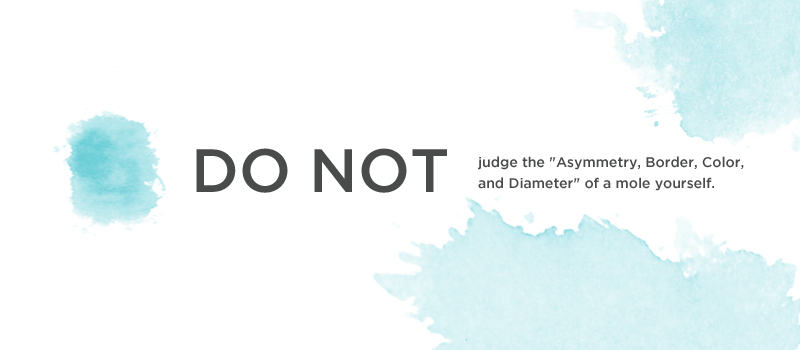Each year in the U.S., nearly 5 million people are treated for skin cancer (SkinCancer.org). This means each year there are more new cases of skin cancer than the combined incidence of cancers of the breast, prostate, lung and colon (SkinCancer.org).
One person dies from melanoma every hour. Skin cancer progresses year-round, even though the sun is a carcinogen and people are more likely to be concerned in the summer months. In fact, the Skin Cancer Foundation says people who spend time outdoors in the winter – especially winter sports enthusiasts – are at increased risk for overexposure to the sun’s UV radiation (source).
If you think you might have skin cancer, take the following five steps:
1. Consult a dermatologist immediately.
The wait times to see a dermatologist are now two-and-a-half months (Merritt Hawkins, 2014). These wait times are often even longer for conditions like skin cancer, which are often paid for by insurance, as some dermatologists want to maximize out-of-pocket procedures, like Botox or chemical peels. (Hey, dermatology is a business too!)
NBC News went so far as to say that the ridiculous wait times to see a derm could “literally, leave you dying to be seen” (NBC News, 2011).
Thankfully, there is Dermatologist on Call, a 24/7 service available online. For just $59, you can get to consult a board-certified dermatologist. You will upload photos of your condition and submit. The vast majority will receive a response within 11 hours, but you are guaranteed a response and full treatment plan (including prescriptions or surgical recommendations/referrals) within 36 hours. Best of all, you will have access to the dermatologist for 30 days.
I am a huge believer in Dermatologist On Call, and I’m happy to talk about it every chance I get. I met the founder and CEO several times, and I’m very inspired. I think this is a huge part of the future of dermatology.
2. Do NOT judge the “Asymmetry, Border, Color, and Diameter” of a mole yourself.
In the age of WebMD, it seems we’re all typing in our symptoms, trying to figure out what we have or what we should do.
But when it comes to skin cancer, even MDs have issues. In fact, when using the blind eye, primary care physicians detect skin cancer with about half the accuracy of dermatologists (Archives of Dermatology, 1996). In the study, primary care residents failed 50% of the time to diagnose correctly both nonmelanoma and melanoma skin cancers, and 33% of the time they failed to recommend biopsies for cancerous lesions.
If physicians have these issues, I am willing to bet the average person would have even worse accuracy. Please, do not try to diagnose your own mole or suspicious lesion.
3. Avoid harsh skin care ingredients near or on the suspicious site.
I’m all for increasing the rate of cellular turnover in the skin — Retinoids, for instance, are known to increase cellular turnover and result in fresh, less lined skin (New England Journal of Medicine, 1993; amongst many others). And we all know how fresh we look after an alpha hydroxy acid-based chemical peel, especially at concentrations of 15% or higher. Ooo la la!
But as much as I am for anti-aging, cell turnover-increasing ingredients, keep in mind that skin cancer is a form of cancer, indicative of uncontrolled cell growth and maturation. I would personally go back to a very basic cleanser and moisturizer near and on the suspicious site. I also would personally avoid agents that are known to aggravate the skin, including:
- Alpha hydroxy acids (i.e., glycolic, lactic, malic)
- Beta hydroxy acids (i.e., salicylic)
- DNA repair enzymes
- Growth factors
- Microdermabrasion creams, exfoliants
- Retinoids
- Very concentrated anti-aging serums of any kind (i.e., Vitamin B, Vitamin C, etc.)
While none of these agents have ever been shown in any peer-reviewed studies to aggravate skin cancer, I am making this as a personal recommendation, one that I would do myself and instruct friends and family to do the same. While these agents enhance the action of cells acting normally, I do not know for certain if they enhance the action of cells acting abnormally as well. So I avoid them only at or near the suspicious site.
4. Change your diet.
I recommend changing your diet for the long haul.
The skin is your body’s largest organ. Studies show that eating and topically applying beneficial ingredients, like vitamin C, is more beneficial than only eating or only topically applying them (Journal of Skin Pharmacology and Physiology, 2008).
What’s more, certain foods have been shown to slow or impede cancer development. In his book Anticancer, clinical professor Dr. David Servan-Schrieber M.D. Ph.D. was diagnosed with brain cancer three times, and he investigated the anti-cancer potential of certain foods and lifestyle choices on his own. While he eventually succumbed to the disease, he lived far longer than was originally predicted, and owed the increase in his life to the nutritive benefits of fruits, vegetables, garlic, turmeric, and other foods mentioned in his book.
Truthfully, I do not believe there is evidence to show that nutrition is a cure for skin cancer. But I do believe that it helps keep cancer at bay far more than eating a pro-inflammatory, sugar-rich, simple carbohydrate-based diet that so many of us in America consume.
Bottom Line
If you suspect you have skin cancer, immediately book an appointment with Dermatologist on Call, or a dermatologist in your area. Do not go to a primary care physician, as they have been shown to have about half the accuracy of dermatologists in diagnosing skin cancer, and do not dare try to diagnose the lesion yourself.
If you want to be proactive in your care (perhaps while waiting to see a derm), simplify your skin care near and on the affected area, and streamline your diet to fruits, vegetables, whole grains, and a whole lot less as much as possible.
What are your thoughts on this post? Let me know in Comments!




